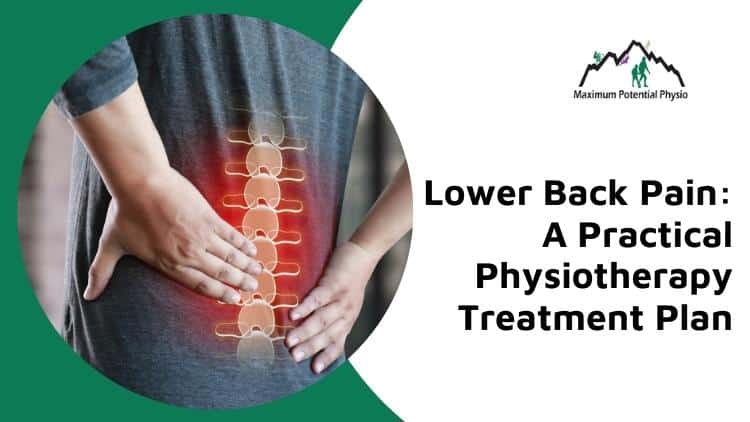Lower Back Pain: A Practical Physiotherapy Treatment Plan You Need To Know

Practically everybody experiences lower back pain eventually in their lives. Even though you aren't a person who is seated in front of a desk all the time, the strain from lifting heavy items or lugging them for extended periods, extended reaching or stretching, playing sports, running or any range of other activities can cause lower pain in the back. Luckily, there are numerous ways to relieve lower pain in the back and stop it from repeating.
Reasons for lower back pain:
- Sciatic nerve compression
- Poor posture
- Poor range of motion
- Core muscle problems
- Muscle spasms
- Degenerative disc disease
- Disc injury
- Abnormal spine curvature
- Muscle strains
- Muscle tension
- Muscle tightness
- Neuropathic pain
Developing a healthy lifestyle can go a long way toward helping prevent back pain. However, when pain does happen, there are a number of effective treatment alternatives readily available that can really help reduce the pain and reduce reoccurrence. In this post, we'll have a look at some assorted physiotherapy treatment plans for lower back pain and their effectiveness in eliminating discomfort and protecting against re-injury.
Manual Therapy
Among the best tried and true treatments available, manual treatment is a powerful technique to care for lower back pain. Physiotherapists employ a range of hands-on mobilization techniques, including joint mobilization, soft tissue re-positioning, stretching exercise and electrotherapy, to reduce swelling, boost blood flow and alleviate pain. In fact, a 2017 paper found that hands-on treatment was the most beneficial treatment option for lower pain in the back.
While hands-on therapy doesn't always get rid of the underlying cause of your pain in the lower back, it can relieve pain and reduce recurrence. If your discomfort is caused by a specific injury, such as a sprain or strain, manual therapy can help reduce swelling and bring back flexibility and strength to the affected location.
If your discomfort is caused by excessively tight muscles, manual therapy can help to restore them to their normal length and pliability. It is crucial to note that hands-on therapy can take multiple sessions to begin eliminating pain. It's best to consult with your physiotherapist prior to beginning treatment.
Ultrasound Treatment
A therapy technique that supports tissue recovery and pain relief, ultrasound treatment is also often utilized by physiotherapists to treat lower pain in the back. Although research is mixed relating to the efficacy of ultrasound treatment on lower pain in the back, some research studies have discovered that it can substantially minimize discomfort and promote healing among patients. In fact, a 2019 research study found that ultrasound therapy is just as reliable as medication for alleviating pain.
Like manual therapy, ultrasound therapy works by increasing blood circulation and lowering swelling. It likewise promotes tissue healing and can be exceptionally successful in alleviating soft tissue injuries. When it pertains to lower back pain, ultrasound is best applied as a treatment to alleviate discomfort, reducing recurrence when regularly used as a component of a pain management program.
TENS Units
Transcutaneous Electrical Nerve Stimulation (TENS) is another treatment method your physiotherapist might employ to ease lower pain in the back and promote healing.
How does it work? TENS systems provide mild electrical impulses to the nerves near the spot of your pain, reducing the sensation of discomfort. Some TENS systems have discs that are placed on the area of discomfort, which extends the benefits of TENS treatment. These discs can be utilized on their own or with a TENS system.
While TENS devices and discs are successful in relieving low-grade pain, they do not provide lasting relief or treat the underlying root cause of your discomfort. They are best employed as part of a short-term pain management strategy, such as after an injury. While TENS systems and discs demonstrate promise in minimizing pain and promoting healing, they are not suggested as a long-lasting therapy option.
Exercise
Routine physical exercise is among the most effective means to avoid lower pain in the back and the onset of other health concerns. If incorporated with other treatment options (such as medications and manual therapy), physical exercise might be all the more effective at eliminating discomfort and promoting healing. Your physiotherapist can propose particular movement and stretching exercises that will help build up and loosen your muscles, enhancing your lower back health.
While aerobic workout is most commonly recommended to deal with lower pain in the back, resistance training can likewise reduce pain and promote recovery.
When it concerns lower back pain, frequency and time frame matter. Frequently taking part in moderate exercise for about thirty minutes can help reduce discomfort and promote recovery, especially if you're experiencing intense lower back pain. If you're experiencing persistent lower back pain, you may really want to consider high-intensity interval training or HIIT: a kind of workout that has been shown to be effective in promoting recovery, building up muscles, and decreasing discomfort. Again, your physiotherapist can recommend a workout program that's particularly customized to your distinct condition.
Recap
Lower back pain can be excruciating, most especially if it's constant. While there are lots of ways to alleviate lower back pain and help prevent it from recurring, it is vital to tailor your treatment approach to your specific needs.
While one treatment may be effective in dealing with discomfort in one person, it might not be as effective in another. It is essential to be versatile and try several treatment options with your physiotherapist till you find one that works best for you.
Call Maximum Potential in Calgary NW today and we can begin eliminating your lower back pain. Now scheduling new clients!
